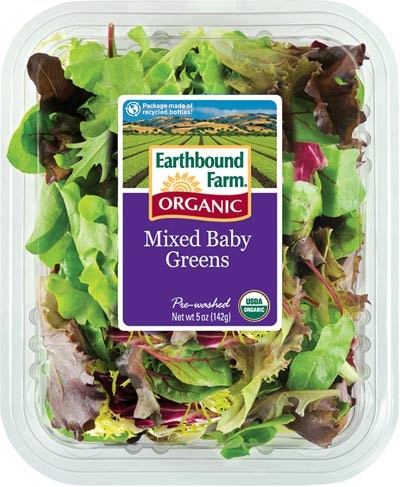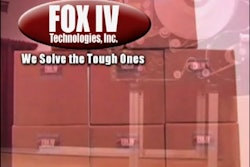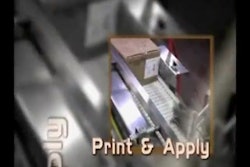
Earthbound Farm announced in July 2009 that all of its plastic clamshell packages are now made from 100 percent post-consumer re
There’s probably not a packaging professional who is unaware that polyethylene terephthalate (PET) dominates the categories of nonalcoholic beverages. What’s less diffused is awareness that PET issues—for better or for worse—extend beyond beverages and carry ramifications for many categories of consumer packaged goods. It behooves potentially impacted packaging professionals to have a fundamental knowledge of the properties and applications of PET and of its impending developments.
Reciting the alphabet
By family, PET is a polyester, a polymer formed by the reaction of an acid and a base, in this case terephthalic acid and ethylene glycol. So as not to fall under Food & Drug Administration jurisdiction as a sleep aid, this article will not delve heavily into the chemistry aspects; nonetheless, it is important to understand that the basic properties of PET can be modified by changing the number and proportions of acids and bases as well as by varying the parameters of the manufacturing process. The resulting resins and the structures are differentiated with a letter prefix or suffix.
APET (amorphous polyethylene terephthalate) has high clarity, the closest to glass of any polymer. Amorphous describes an arrangement of molecular chains that is random—rather than in structured alignment—which accounts for its clarity.
PETG (polyethylene terephthalate glycol), being amorphous, also has clarity. The addition of the modifying glycol imparts increased melt strength.
CPET (crystallized polyethylene terephthalate) has undergone crystallization—a structured alignment of the molecular chains. The main consequences are: a decrease in clarity (the material may retain some transparency, but is typically opaque), and an increase in temperature tolerance, ranging from freezer to oven temperatures.
Decision making
These examples indicate how the term “commodity” is misapplied in reference to packaging; no matter how seemingly standard a material, modifications—present or potential—should be considered. The objective should always be to optimize the match between material properties and end-user applications.
A straightforward part of the decision might be deciding on: APET because you want the product presented in glass-like clarity; or PETG because you require deep-draw thermoforming; or CPET because you need microwavability. It's improving upon that basic decision that helps justify your salary. In short, you should strive for innovation, not just for its own sake, but aligned with the core persona of your brand.
Is there consensus throughout your company regarding the brand’s personality, one that can be succinctly stated and that incorporates a differentiation that’s meaningful to your target consumer? If not, efforts to use packaging to enhance the brand are going to be a crapshoot as your company mistakes the marketplace for a casino.
Take, for example, a packager in the personal-care industry that considers switching its bottle from an opaque to a clear package, in other words, from high-density polyethylene (HDPE) to a PET copolymer. Is there something about the product’s appearance, such that visibility through the package would entice the consumer? If not, the benefits of a switch may be illusionary, not only failing to enhance the brand, but also adding to material cost. On the other hand, have all of the potential advantages of HDPE’s opaqueness been explored? Would adding color better convey the essence of the brand? What about pearlescence, heat-transfer printing, or any other color treatment that HDPE offers?
Obviously, many more considerations come into play that should be prioritized in accordance with the brand’s core persona, coupled with the competitive realities of the product category and the industry. That’s true of all packaging decisions, though a growing number of such decisions will involve PET.
PET made its initial gains in applications previously ruled by glass and metal. More recently, its suppliers have turned their sights to other plastics. HDPE has already been mentioned, and polyvinyl chloride's (PVC) dominance in certain thermoform applications is under attack (see The clamshell in a nutshell Packaging Insights, June 6, 2009). Another plastic that must fend off PET's advances is polycarbonate. Converting the discussion of those three materials into end-user industries, this means food, consumer nondurables, electronics, toys, and medical devices; each of them high-volume categories, and that's just for starters.
As a result, this generalization: If the application involves a rigid primary package, there’s at least a modest probability that PET or one of its copolymers deserves to be considered. That generalization, however, should not be misinterpreted as advocating PET; for in many possible scenarios, PET is not the ideal choice.
Remember RPET
RPET (recycled polyethylene terephthalate), for all intents and purposes, comprises reprocessed beverage bottles. Packaging applications—versus textiles, carpeting, strapping, etc.—are overwhelmingly bottles and thermoform sheets.
Assuming that recycled materials can produce environmental benefits, equally important is that they can yield commercial benefits. RPET should make good business sense. Achieving that aim requires three interrelated things:
1. It adds to the packager's reputation as environmentally conscientious.
2. The reputation favorably influences consumer purchase behavior.
3. There must be no sacrifice in quality, performance, aesthetics, or convenience.
Implied in all of this is an established package research and development framework. Also needed is a communications strategy that effectively informs the consumer of the recycled nature of the package. A complicating issue is whether to divulge the percent of RPET within the package. Coextrusion technology allows RPET to be combined with virgin content, even sandwiching it when direct product contact is undesirable. For example, if the label announces 35% recycled content, does it expose itself to one-upmanship by another that boasts a greater percent content?
The best is not good enough
Thanks mostly to deposits on beverage bottles, PET is the most recycled plastic. Still, a sizable tonnage of PET in all forms is landfilled. Therefore, choosing PET is not an automatic "pass" to sustainability. There's also its petrochemical origins to consider.
Ironically, the existing recycling infrastructure for PET—modest though it might be—is part protection against competition from bioplastics, particularly PLA, polylactic acid. Bioplastics' resemblance to PET can cause it to be misplaced into the PET recycling stream and contaminate it.
Recyclability has not shielded bottled water from withering environmental attacks. Lately, bottled water has drawn safety concerns regarding the advisability of leaving it inside a hot car or other locations of elevated temperatures. The feared result is the leaching of carcinogenic agents from the package into the water. The lesson here is that a high-profile material is a natural target of detractors, wrong-headed though some might be. That’s worrisome enough for packagers, but in this era of instant communications, such attacks can quickly become viral, and indict other packaging through guilt by association.
In all, staying abreast of the PET front is the best insurance that PET projects don’t turn into PET peeves.
Before becoming a packaging consultant, Sterling Anthony worked for Fortune 500 food, healthcare, and automotive companies, and has taught packaging at the university level. He welcomes your comments by phone, 313/531-1875 or by e-mail, [email protected]. His Web site is www.pkgconsultant.com.
Reciting the alphabet
By family, PET is a polyester, a polymer formed by the reaction of an acid and a base, in this case terephthalic acid and ethylene glycol. So as not to fall under Food & Drug Administration jurisdiction as a sleep aid, this article will not delve heavily into the chemistry aspects; nonetheless, it is important to understand that the basic properties of PET can be modified by changing the number and proportions of acids and bases as well as by varying the parameters of the manufacturing process. The resulting resins and the structures are differentiated with a letter prefix or suffix.
APET (amorphous polyethylene terephthalate) has high clarity, the closest to glass of any polymer. Amorphous describes an arrangement of molecular chains that is random—rather than in structured alignment—which accounts for its clarity.
PETG (polyethylene terephthalate glycol), being amorphous, also has clarity. The addition of the modifying glycol imparts increased melt strength.
CPET (crystallized polyethylene terephthalate) has undergone crystallization—a structured alignment of the molecular chains. The main consequences are: a decrease in clarity (the material may retain some transparency, but is typically opaque), and an increase in temperature tolerance, ranging from freezer to oven temperatures.
Decision making
These examples indicate how the term “commodity” is misapplied in reference to packaging; no matter how seemingly standard a material, modifications—present or potential—should be considered. The objective should always be to optimize the match between material properties and end-user applications.
A straightforward part of the decision might be deciding on: APET because you want the product presented in glass-like clarity; or PETG because you require deep-draw thermoforming; or CPET because you need microwavability. It's improving upon that basic decision that helps justify your salary. In short, you should strive for innovation, not just for its own sake, but aligned with the core persona of your brand.
Is there consensus throughout your company regarding the brand’s personality, one that can be succinctly stated and that incorporates a differentiation that’s meaningful to your target consumer? If not, efforts to use packaging to enhance the brand are going to be a crapshoot as your company mistakes the marketplace for a casino.
Take, for example, a packager in the personal-care industry that considers switching its bottle from an opaque to a clear package, in other words, from high-density polyethylene (HDPE) to a PET copolymer. Is there something about the product’s appearance, such that visibility through the package would entice the consumer? If not, the benefits of a switch may be illusionary, not only failing to enhance the brand, but also adding to material cost. On the other hand, have all of the potential advantages of HDPE’s opaqueness been explored? Would adding color better convey the essence of the brand? What about pearlescence, heat-transfer printing, or any other color treatment that HDPE offers?
Obviously, many more considerations come into play that should be prioritized in accordance with the brand’s core persona, coupled with the competitive realities of the product category and the industry. That’s true of all packaging decisions, though a growing number of such decisions will involve PET.
PET made its initial gains in applications previously ruled by glass and metal. More recently, its suppliers have turned their sights to other plastics. HDPE has already been mentioned, and polyvinyl chloride's (PVC) dominance in certain thermoform applications is under attack (see The clamshell in a nutshell Packaging Insights, June 6, 2009). Another plastic that must fend off PET's advances is polycarbonate. Converting the discussion of those three materials into end-user industries, this means food, consumer nondurables, electronics, toys, and medical devices; each of them high-volume categories, and that's just for starters.
As a result, this generalization: If the application involves a rigid primary package, there’s at least a modest probability that PET or one of its copolymers deserves to be considered. That generalization, however, should not be misinterpreted as advocating PET; for in many possible scenarios, PET is not the ideal choice.
Remember RPET
RPET (recycled polyethylene terephthalate), for all intents and purposes, comprises reprocessed beverage bottles. Packaging applications—versus textiles, carpeting, strapping, etc.—are overwhelmingly bottles and thermoform sheets.
Assuming that recycled materials can produce environmental benefits, equally important is that they can yield commercial benefits. RPET should make good business sense. Achieving that aim requires three interrelated things:
1. It adds to the packager's reputation as environmentally conscientious.
2. The reputation favorably influences consumer purchase behavior.
3. There must be no sacrifice in quality, performance, aesthetics, or convenience.
Implied in all of this is an established package research and development framework. Also needed is a communications strategy that effectively informs the consumer of the recycled nature of the package. A complicating issue is whether to divulge the percent of RPET within the package. Coextrusion technology allows RPET to be combined with virgin content, even sandwiching it when direct product contact is undesirable. For example, if the label announces 35% recycled content, does it expose itself to one-upmanship by another that boasts a greater percent content?
The best is not good enough
Thanks mostly to deposits on beverage bottles, PET is the most recycled plastic. Still, a sizable tonnage of PET in all forms is landfilled. Therefore, choosing PET is not an automatic "pass" to sustainability. There's also its petrochemical origins to consider.
Ironically, the existing recycling infrastructure for PET—modest though it might be—is part protection against competition from bioplastics, particularly PLA, polylactic acid. Bioplastics' resemblance to PET can cause it to be misplaced into the PET recycling stream and contaminate it.
Recyclability has not shielded bottled water from withering environmental attacks. Lately, bottled water has drawn safety concerns regarding the advisability of leaving it inside a hot car or other locations of elevated temperatures. The feared result is the leaching of carcinogenic agents from the package into the water. The lesson here is that a high-profile material is a natural target of detractors, wrong-headed though some might be. That’s worrisome enough for packagers, but in this era of instant communications, such attacks can quickly become viral, and indict other packaging through guilt by association.
In all, staying abreast of the PET front is the best insurance that PET projects don’t turn into PET peeves.
Before becoming a packaging consultant, Sterling Anthony worked for Fortune 500 food, healthcare, and automotive companies, and has taught packaging at the university level. He welcomes your comments by phone, 313/531-1875 or by e-mail, [email protected]. His Web site is www.pkgconsultant.com.


























